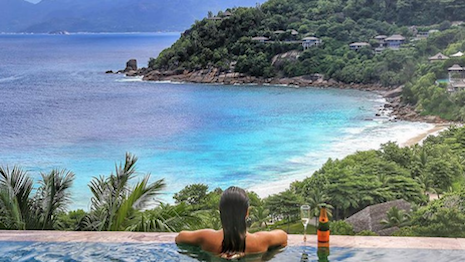The gap between the average traveler’s vacation spend and that of an affluent individual is widening, with luxury vacationers outspending the rest by more than six times the typical amount.
According to EyeforTravel’s “The Global Luxury Travel Consumer” report, the average traveler spends around $1,690 per trip, but the luxury consumer’s budget is approximately $5,365 per vacation. As the cost and frequency of affluent trips increases, the hospitality sector will need to respond by curating exclusive experiences and amenities to ensure affluents continue to be enticed and not become bored by standard stays.
“Our research suggests that despite the challenges, it pays to focus on the luxury traveler,” said Alex Hadwick, head of research at EyeforTravel, London.
“For the rest of the market they are also worth keeping a close eye on, not just because of their profligate spending but also because they are at the forefront of trends and leading-edge consumers that can help us figure out where the wider market will head in the future,” he said.
PTO bliss
Not only do luxury travelers outspend their average counterparts by more than 600 percent, the affluent also take more trips throughout the year. EyeforTravel found that luxury travelers take double the trips per year, or about 5.6 vacations annually.
Due to affluent travelers' higher vacation budgets, the per annum spend is more than $30,000. This figure, of course, is bound to increase as well as the amount of trips is increased.
Per the report, 16 percent of affluent travelers report planning 10 or more trips in a year, compared to 2.5 percent of average consumers booking the same number of vacations.
Also, the ultra-high-net-worth population boom is beneficial for the high-end travel sector. The demographic is expected to grow by double digits into the next decade, adding millions of consumers into the luxury market.
EyeforTravel expects this trend to continue and the gap between the average traveler and an affluent one to widen further as experiential spending becomes more of a priority over material goods.
Developed economies currently lead this trend, but emerging markets with new wealth will likely transition quickly from material purchases to looking for more memorable experiences.
Travel and hospitality brands must be aware of this shift in sentiment because the experiential trend changes consumer behavior as trips are booked and excursions are planned.
EyeforTravel recommends the sector works to develop more high-end tours and activities to ready for travelers’ experiential properties, regardless of economic background.
Also, when refurbishing or planning a new-build property, high-end hoteliers should keep in mind travelers' interest in unique accommodations that leverage a destination’s local character.
The same can be said of on- and off-site activities and amenities, such as spa treatments and dining options, that add to the overall appeal of a destination rather than a cookie-cutter experience where the location is a second thought to the hotel brand’s signature.
Shopping sprees vs. adventures
For hotel properties with on-site luxury boutiques and destinations that rely heavily on tourist spend, the shift to experiential travel instead of going abroad with the intention to shop, will require a strategy adjustment to balance travelers' evolving preferences.
In its report, EyeforTravel notes that affluent Chinese travelers, long known for their luxury shopping habits while overseas, are beginning to shift away from this behavior. Instead, affluent Chinese are moving toward experiential travel activities and accommodations.
Going forward, it is likely that the Chinese affluent traveler will put more emphasis on adventure and exploration and less importance on high-end shopping sprees.
This behavioral change will impact the luxury economies of a number of destinations such as London, Paris and Milan.
In 2016, 81 percent of Chinese travelers planned to shop while abroad, but a change in preference could dampen the amount spent (see story).

Chinese travelers often shop heavily while on vacation. Image credit: Peninsula
According to YouGov, overseas travel coming from China is continually growing with more Chinese traveling overseas this year than last. These tourists will likely result in about $315 billion in travel revenue in 2017 and see the biggest foreign travel spend in the world.
It is likely that 192 million outbound tourists from China will travel overseas by 2021 reaching a spend of $419 billion, but if this figure is spent on material goods or experiences is not yet known (see story).
“The luxury traveller is at the forefront of a number of trends, including increasing the amount of disposable income they put toward experiential items and leading the charge for smartphone usage in the travel research and booking process,” EyeforTravel’s Mr. Hadwick said.
“This, on top of their huge annual spend, means they are a critical segment to understand in the travel ecosystem,” he said.
{"ct":"fN\/GQ+bGK9rMm1d+kyBCFtKPYRyJWIdI+JLoBieDAAmPyAOLZrs7DVHHd5DAurahkIesSZM6J92kp9NqH19c1JTYUUNsS+2Q+\/O2wx+xWqQZiVO4TyRVH0FCC63UmBo8b3kZs9y+15uceTFNGm5DhWcnBvyiPUtTwPTCyZpoGC5AjZ76NyD9PDlCvzJ6nbgX+Ge9eY9KjNHrEtyhaHmGhP4iVTwKUmM1q1U4tEM6yjSGH15Ix\/xrg3MEXkM8IdORQGmsB+kRLQqnUbSWu6NIVhNhYqHoHOFAbNQ4x0BzKD7KBzzjocznTVdPefo6MquC3oui2kup+X6gC1Szk9PYWzdh4PAMWGulQg+Dn2VRWvI\/u2gbkIzP3DbuNnDdeOqdxlUDvMBWUb4+IXcawZeH1jo9PT3pUnHWC677VasDT1VmOALMPsjLNfCWFnh5zOHCN+X\/rKMWegb7hpGy6\/k5UG\/xsdxRWfaIncyhk4roMdf\/WeZovXNroWQ6XAHOurO0\/zWD2uYBrdhVyOGORuZWADH6vNG4Dbil2FRPsX+crlQNAeWF1kn3nR4O7ZC+Oiry2Te\/nIjleVOJoGp66FOCct\/O4pSfMXQ0Ck\/hQZ3FaYZVZv88XXIN3Hwl6l\/KK6Zb3y3MPCca5wFaKeLsSQy+m\/thehAdzV3tBkUK3B1Yv9y3Cdw368uhm0OHRTQMjPy3TgRxsTv+daQ1ClsIhuBQ4PlAu4dJixwL2Q9wm6Whvf4Kfr6g5nz6MFrwgHWkfp2vzED1uYjyIv+v5yEVgkN5S5d3123P7cc4xA0Hrd7Kr3NrGSONBDV0z3DcaKYDRpgZX2DwtHUvRsJxmCLnCJKjXhXAosqEMcAhOnFMQuKz0cf62JR2Q6GKL3tY8H4BcDlrxfRhSYIXIFw88f+27QRShQ6H1wGmDB1CUkkljnvZb01BBLHtFE1aP1Rd2PooMg6YBKKqusRWL96W7m8tgRXy5rxijcNYxbA+DNpryhQwbuKHsQL6DLvzLbRXird6uFEOjWt0RXLY6IDP1PUtapmeuCmm1kI7UL6Cr1IjS7TqNxFl6lFqCk8r1hhecVHQWzP\/xb6aGv7H+ws7FDA5DGbKSClHcU3OiurdUC796tbkKYt+pUK2wObNZv9BI25FSP7v\/bYRA4H2D38M\/DafaTTv9m\/GG4FJDBs8ZeOVcNNrmqU3iUd58lwJaEcn2JMMMlJAHwpLkW9qqA+rVlKRvMRSLBcVMVaCu7BSVKVRCvMHnmrRRxr1QjQsHrvTEytLmtEwFfRANcf6p5hQUwYOkKIImP4JhWpWinDssMHI03rHYwxvv4574EjT+J6cKRSF2TziD21ZSog7FyfyVqVoplXfSBDDOPkCX5ix9slSix2hJIVNC+iT+bVQXdqsO+JPgJgIjAS1RJpvawBTzj4+5QRVpXEeYXHx8Ap3mewIBSw\/nk3EqspClMYquuOq7lcbfb3SCN9FW+MBaH3RN1dQfvRGQWXx0oU2wH0ksmpZgIpCkvUk1SBcw94bzgalsIMbeN8EX1GvZ8gQHJcNXSw3em+IoJEf8R9WAeLQScQItcU0Xre7Vc78sAdaAEEFFLFbwqeJOmn9hNR7gKoP+4VxhY1v4zHvNfkeMQEHaYG6boLD7HwawuSLRuJ7E\/5KOBYu6MC4pJuDh30erMpe7HG9kTZGPLU9HWKYdYLQ9Ar83kaUUyVuwpOjYWPQbN3x0fEQURscsClmKyt4i0Su9GpaGeQc+7pPimkBs8nxMbQm8LagfuBw1ti0ozNW5FoWB8L08np0HeVFvAVUzSiUIh2Ak1rYfgol4EZA\/1wJJfIU14KXRIG\/FjeVm9BVAGomLqy6RccnmeFNbYY5q7rfXVmj60Ga4gNKBGGVEHrS\/d+G6l8CN4MNGaq6iXhpuFeOII+kfNGq6N+liy83zi+X8kfgmjfDZQX6B+JjSckqmed5ajwbA96GdgK+S\/cs0dAxlC1NghHpiiSySMCvQ1S8Nwjw88o9d\/mV5fveYO5JwgESZXRfwRhzb3cGPdLhilBYVtpvgQh5wXVcRjmKYchmCPJr6oU5DaqAyuHYM3VNbbUnw5r2XF6pF9SiNVzQ1S6ekonaIGdTOeLBAni2IvaKu0\/9iX1PfwkGNqy5hN3KZXttTG4kDqtp6BtraneJ+fHrqkcBN1VZ+6jUDwni+oi4YwtjAdLT+kdmaJWgkcmKACVDwWT\/BE5CsCFo1rrkLtARXK4JOZW7kIVBdze9fRzcLEokRxsWLyRGUXdHTmDAfVmVERWfnn7KvPXy7EVzUx+HuqoVbKsDZz987B1tFi5TBZDioJzN78afOsjATd0\/y15eOAX3HsnuNJkzkjct7KIO+tkieJ34MfVJZRxYUHGH8iTHxui0d1phHUXlYADM4TdV2kc68oTp+B5wtICadVL00mOxgjCAJxxeyhLw54Bazu1n4IZYmQZgGG29BGIRYIDlYLD5vuxgtbzXP6bR+66dalvw3NcXM4SKXahoHdGf05Gil0Qbdx69j6IHjefeskyPTKNPfqLWK2M1\/f0jc4tyBRMdGbg8XOL28al3hlvCO0xDNmaGJ2P\/cvnyRSrlUJeKNsDqvdwk8B3kAQ8WtC9X0CWsNzCeGLkEh6Trnww3ocsPM99HW32Ia1nic1cuBJBVj1O\/jOxt2d6OvhBSTBF+ZUStfECHAJEpaZxPaM9DGq\/a3TnLyoOlTST+3M52QEAVBiE3I+V18LllUe0FzyTXuN9UafAjekdbtLrxPm4krqX1LmwHiCCu3tdm4mwybReOrxsw0a35hhPi7PcgUXIrsKdM0dlUPNCrCgPx8sphxR+2w12SCHj1xPXAXRLY96rB3JKRv8IR2uZlFnh4vQ4IurtJjAq843sjlllH7MP54\/eSH\/xXLde1VIQ\/3MyuAXCyvpQHEwNDNp5ZPdf72LJ\/jwgv3Kgqa36C+GcD81IcTXUrZJKgCEQhAMiaC5z14k49Urfah9Y7FbOOpWi4H392WQGZlpvRKrMuBI6x\/b3BAJ5l+csVKJM96b6Op8XeytxV\/oyNYdgcTKiGHXgUueRx0aICa3sU5DweOB6EyNnt8vBdEQblTkfHuDESLIoBV+K0qfyejt9pLQXqbAiV\/NRM2XDlw9uyhuNcsXYIl0I+Z7fKQiJN1kyCfKWp\/3ZvOMCBCHfj\/0dtZOTG\/gFHcMCIdNFpj0cdgQWaJsY0OJK3j3itZM3+8E5S1RrSauc4VAKhptbL+w8zYK+M1IUXNWedITSxt9jjp355uvbv21UhYh9PxYAW\/sLqGDJCSEI2DZv7KsGkqXD5JBL0OsTszuMFW1jXyCGLrxSw4mGpwk14wlr8x1aRWphd6bS8S+IWdEgGzyxS9O6HBuN6WMGo2T1YtVusXxEMpysvStzB3gDrNIApxqWlqh0WSlL0eNM5+ivZ5XiY\/xpkpF\/\/1b8C+lIv5omsgAXdZ\/h5yVPjBXV151y7o2RzRWvVSwhqa57ZT7+fkeMuARnVgT9nGZjxP99QGemx\/WGqUuANv7Sio52o1Y50Xy9Wi6myXP8SMSyXMvIniuxXN\/N+WxL\/rT\/vOmE3Srkx8+eYarlgh70phcUbwD7T6vrTnP+6MCNxslfz31\/UahGpDd7dF1r1ia1awT4N0f12Sw27HGIWzH0qrsl\/h5QloBD8PFwB7meFf8MQ4RbQzMpp3OKQ2pW+3F9ZjUZA2aSj63UaXfxjveOWM85gGQ3QBN7dGSnHyq89TuafBGyIIRSl77cioIhHg05B9hDouX58MG8u9Tm4Ap9SDttvY\/N8UsqKMU9oN6Ezca11q0JtIz+kWl22ID3MUXTdcH+pWQ87LnJCvh0OGwH7S3WRzN0PmTkYGkexS6afVhMbGxRt3+Gl8+FpDxHY12yasyaddCwKMNKgOrOiXsVR6pwwKVVukWmO5z+st2JrrIiSEcyRhQFl3A1c\/x5SH\/W88zHt8eRDdbqTQNGmKOdBG3H0xeR7N6KdMMU+l3fWuw14IW8jRp4A9S3G2ABXqtxGeRcKt\/1anb\/rk5O55PV9ciHY1bwr3uH+91AQE0rYBgOMPqcNmVhMwBMaAfL6MPf\/5bYeNygnDEuNukkWH0oHazKAIykXS3PZYt5WB0zEkFgHUTlgXtYLXCc8Xe\/M3oV\/PGzc8kvBZfnMrAGyasPqSsiGZhu\/NZrntVrFByByedr1fFT\/fXNfrxmu55aK0KHDpvvCTUokUc6BbbbjLa8hvrfn8EJRU8+GvXHR1cLGOMOm0kLQUHuQUtd0fXegBoat\/VHL2imMD8eSTc+iRIKw8g5abrtnCvjJdR7iWCr1KyPfJeez3mqWSxqMMZ+D7RzTQpLd2daZvgOCNoiiKm740Ck08c34boVrmXcBUdFHY8h+S068CS\/nTDzU8nQ5qMJgSg8N70JsrTCORI0mF9kIHgIEoDeu26T037cZHUEprfrhwuHkFi+dKXAYLOJC+Gky53AbMXzKMwL00Jy2gag\/5nnDlFPt7nlSWZiZq4YgCdMJqGuIz6WxCr9OICV1RNMSfBZ\/NYJXSdIunEXEhgxGkfM1orVRB9q5hgqvdHtq+erJGK3iXqyw6eGcLWdHWJ447HM4bc4oyH1N7bZ6FvZ\/SBkBqY8\/C6uAXyIThxPHp6dQ2aKB5x6L\/54\/xi5jM+EWYHbk8coecec0y6EKw5c5\/sCD\/1fWV3Qkcn+5em6Egxfm0zZL+BWGnfMaTP\/rcOuk9yVcl+lS3DOpt8Kn81oaLFPbA\/KD76m7PlK1nCURGVVFFClCA8W3yzl5q4nQ3N8TVrgEiv7fugQwakCa2Vz6\/f3yAw8oesGpTSWOHJjxl0lmgrVXUHQ08aST1WGv+fywVgKazd6C7WDJrDTXgx8t0N6vX\/JmMpZumlMO\/46OjyNPaJ\/So7tav92iA4\/Z\/U+2+rN\/Uq\/YftvnpicdX5R8xuVh\/7RgJvQCpw\/4ojnx05biGAh0K8ovPn32Z\/XF9VlZKjFyCwWxbrANW221tlipt5961cnC8KU+x+4fBQEojBcHcdcpOuDCd30xQt5e7UEMVfajED5\/xq\/QlR6SVmAf0z2Nvmp\/Ztfp\/jtP3vc\/HKrwUoAo6PNgcWLTpRi9QU1xMXiqo5m\/L23jRp1FRmxee3Ns\/L6dBi5uyK8P0oDsNxQIz4YH9kmwHp7VMYVsoIh+W275Uwuo+S28ltByu7nMxka7BjNZaodsJNr1XsRmGoqK+e9+6zs4BRkN5C2wC61s\/eyMTJ5H1LwBVaUebuyLtcG7LCXSTNOQOC\/b7UUrQSRZa50JAQ88rTAhwrJWmhlOHXuE3G74uj+UXQjaAbVm130RcM38cflKRk\/mip41nPUUxKclIvKhK4vCK3gSJq8i1+3gXkcgeZRPDLYWxYa+a7slnjnXbG1WpaAdt5AYk5aDYMHw0W2tgCZmlrgws4pYOv\/X9rWzcOv3jsCf0mtw4WJHIj6Yytq2ObFaCtrmeFQns9a05tLHzXJ5h+XAsAMziYkfRtNrsLSf2u+F2pbqSXJG37T\/lxDUtoTox5IcMCtw29y92zxw6sQCkIhlTa6gFXIenjuLqUOrSN3XA5tl1qvdtanftCoFwyr4QCe\/iZnBHwoDCo4vjRQwafgGpeQN\/EK+b3zcuUOQMdTNgtL38J9qf1CYiuJ\/62vSnYOTW3wafOb7Tz23xHNoskRiTMfC4IIm1dN1L2c\/VDiK4wWeJoEQpOM5CxYuyfFGmvI4NBDAHGGPk0Ir3WZhDTJkp+o2nrlMQe5hhGG7G3xNaqdk9jb2epM9zta1wajeCW1gsVl34pAqem5oxIZGOcVMzmtV2q1vqMnnB2zGHcfV0b\/m4uf8crZ4sAenfeCZt7S1ITpjPDeCY9UTpMOv9iAr7mScyHMM9\/NeZ1cdKtctMrlNwNh+YwnvNl\/gkCMlEcBQZFQhj0Xf\/3tXI86ez1DG2WyYXr3kkII8pon2HtKbFbLejAugLHdmnR3vuKrP1KF\/UN5B83c\/nMiSvyM0aXD0cjB45QiZGldnH8OSverCtZQdtsaluR4A88favD\/O+NBWpves\/pIYGK1rcYFVQ\/HpjYfh4v9gk2TgPKN31\/E1aDNzO9tasVEGyWpYaS0n1JygQVJqxHGyCq8\/0mCVU1rzFYEkFBDNNY+dRUBjc3V8HnuYzB5PzMM+NwcVW28Dd6iU\/BdtDq24yFgMz1kIySy6rCCfcBSBoW5ELWyZXpIDETGmkuztZQ6uzzv8jbFc5kb0PySZRCgxumVaEy9MaYx1RvHWpwxoUcKdl2s7\/LGYPShPBYPJ0K57HGhKh9LlxCYOP8\/7XKsW61ERbZwjjSk66yvtblIFaFgv4mJNJ3\/mIG6AKU7\/U3wKzwILBxIvFgsm5XZpeVxDBxokyFav2gibDjH+6GYVuY8kqFCt3yHIoX0T\/uvwQIHVbylnGdSmhbGpqiGvyqOI\/WnTto24cD\/C3vyUdGrlX5MzKkKkU\/cHXz2Xax07AcqnV9\/UdY+fp+i2h9WSleUbMAAoequ6JCE3abhZ+KmK\/3xjpMuA1mNAiv6W6kCt7grSDxzVVVWUv6eIBTe6\/FHxnqDrHouUTiZAQjwc8ORYl3BbfGdFqNxjYjbsJQBnPorQKzltezuURfSDaSlKMfjxVt4MAv3gRodo73qlH1iVL4h\/3aD05tYpVA7RnL8mb5FRbwxWa+xE6dQ85gdWEHUBCoz0Ep3SkO0xcyCQjoitF6n9K9N+Z+5gWS3O0k++Z8EQWQk9ScaufRigxoKMeue8C8E2XX82vAjSa9H5aU+AdX9A2QEzrZvLljTsLQLyOiGTMVO\/AtkFbprL+IzHjj9f7J9ORsIy1tZunbzQ9mdJcxd6X08r\/oGTI47QnEJgj3eL0jwAV04zJpVJAx94HVykYCtidALy0xKfktTv8ItiUgwdDSz9RtpgeiuRcRpH72mHWYGO2pMj0R9ktNp8fymtzZJLDppg93KzfAFPJqdRfl0ZpoOvgo9jVAZ76gx0MzxDBTOJw7OFDW0QcNd4bhHuBiiEFiqW++wIm8Jf\/28jvOlwuRE1+hdfqt+k6hzvBnJfX+5bjlB0krOl7pHcsD5DDdUeaeSCBmDvD0OXF6EYIBOdSZWt7zJxyC4BA+ddjpIm0DQkGAqRWGBDImYPdzIAleTMHYr0fIv2AXuEQZAwEKKLfWDcnXMC0Kk+Csr4OGlXMYBeapYtwb9tXxnvv77zIgJMF73NLCoEFOj1lsHz+4XEfRiuqKVWsUjOsDotQX5Q0COI1cs++sJupYCMqZyNFCNMZa64q+aFeW6qQan3xjyMIP5tDT8Q8Oqxlkg36T8OvCzc+KyAO4vEIPxy5yWITWlu\/FbwFCRyPJL4cF0Z8I8EaTzXD+bveqfdrCawi0G1QqIgC0m2TyOiz0zYB5GLj21DJF1ZI3zu7li2aA6dLIyOOrLls1VxiH4wE5MPb7ElJ0DVZyy2mPAd9B+mgoe0LNiCxKboBB0D9qpOf4o6XhHJMy+UvYgeAltXi3AZvspaoMb6Z0tgRV\/JI8EvsJjIZ9PK\/vGPdbTUUxHHxFx4rUQtgxxq6AEUxO2rZYE61oOTMJB+CdO3UCakEs0xp6G6RD5Jln566IpDmgM49JIOI05aaeM\/zMQeMYn40WMJfGPvPN3W4OCC9JnWJHBRQze0bN+AC4ZRI\/AIvVkB1us6QiqBkk0\/yaRSlXsomM9\/Q8IULdWP+isT\/Cq727U2HgnMaSijCfCM4ag1u281EVeQrcom2IMg2RAwe416SIa4e7Kx3nqtmV+ft1iXA\/OhKM\/TtgR8pz5ngebpRsqk0LZCRRJjbmDYSXcZcFJYURkI+FYD49QteeMTf\/AJFtbiWJ1WyWxWPun9RqNWMFKqXs6jz5ojaRvr\/6MzsiD2cPY\/Pn8P\/8CCcy9zi7qtMB8RLRXb23\/NoCEpgIGTItXepHOX\/DZhZij6SwISbVvchcVWOz71zPvUfuXG328EUozKInL+2eHbYWVbrsMFMwYXphHtFtcyyYIAtNQhHkxKOl0Csr1T5Mlj2z+3gEHj0tQ\/+Xq2WSht8F87ZREQwSTABBhBmsm9I6CUIrI15paeMlOnSJ3zoVhPRHpLcEQakuxT+d7Y1KlSXxvwIbNZxWfUcbsyLlatlAUM27rRs\/pKnertk4t+EfNkV8U4dMT+58JcPdy5i0+MIMbzGWg4arrkvE7mw3hKuuSDDFqRhMNNvM97pJrMOQlvbPJK2BS7o2f6BLIGeYCx3CbYJJLboHwfynX7KeWGWUyYm5rWcIWvTjHezepdsda3sqzb\/1crnMIcak+qJb5e1GBz65vdSCmTiI9bZ65JVlefiW78YsObZSl5JLoy5jE8Hua2fZ6KFV5mKjN\/pl7kk97fTumcqU3An5rndghm44QAq47RVLwwVvUD\/CNDISRq5AHuC6CjgA2UPi4Sx0tOzNSXPUFlbmPOdwKdai36TzZ3T\/1jI68KJQUf5SELiK9qGc0VKa2odU1o4MC1k7o9YBFIzfIda8EMninwFDT79xqHzrSaEb5m6DEEJihvCV4H5VJuLVRxPEVsZf+ZW7fVQJnLtVELDWrbwEYSf+uLggKWf8eP7hPyFbSw+CSDQNzCy\/teoSxK4AOhOuFRpXgtfj2iB7vcmlFDJotjyTFK861kmmOu\/bk81OhBtLXLjWBNQHyjy6IGGTwxOGYssSwqpTWRCP8KCdGPe3afAv9JswtGf8IeJ33iNMEyFRSni7qFjFa3r5Qm+EUlfNq3lGIpf1iivSS6hCheQ4XQUF9YjF6y3Cn3MLbzbygyjgfkSFCjyfTK6lWSTDCUP+QJKcIv4eRAaSviHhi3kpt7kftzF986daRobLu4misbnRel1O42+9M3\/SxBN9BRRFUyAVq+ppAAy7n01QF5fmuUgmKBZmxFD780pzKw6YU+OfvY4S+em1SXlybaqaGWPTXPkCQI8eX+dAOLES38rF+kUcUXOSGO82jQnbM778CqFpADC6aSyQVhJAhzj3heeo+DWeCx\/AmdihMlUfflg\/Vy+NdjzJ7dXpQr\/teiYtiqdnQYRQhw6t6myUAs\/BNDsWB4+ac2\/RBBBsbpPOYACo5JX6nVMIYBtxR4tcwboIHKmsAwfDeYanXf\/6IRHLaHjGXPwnRA9mZUTHEzMVlMqu2qnrCWjx5vy5vHF7L3FB8UuH6n9dU6DNvhazpMJO7cZUFGEm8Qwe7Odc5y0axymdy5bQdABk1B5Ufnjp+kPqbrsdumoj7NIicIxcR+fsYAGv9V0TOMmXIUk7MXlrXYXWEAPssPjQoRhFEat6GlDcTiKy8Wzy8t3DVoZKpa1B61Dq5bYBwf7NkNj8mQHF6UQlWTQkYUk1aOtCIMwaUPSxGGfmLlYvLMWl35fs2iavDJ9WEEQCtcDFBZ+nQJOnlLGwDVvQ0V\/nYxcthflj\/NkY0pocIIR52WdGRO63TKJ45RnZHMBmMyUfO0ibPHq0iDYAj\/UD\/Z2daFhvtoDmLy5JzwgpkAgCEK7vvSLUGb+I05PMDLQ0SQqCtwqjfsXxVI1E5rmntcTEv+mFwevN3TQx9P4oKMBy8qCPoL1kyu2O4vGL8pJCKHbU9U5Z3iNE+RrDAVJINj7GyYZFOQ5pBF2NQHh7rYe6I7dJwBeCWaRoqVg8iDMAjgZKhV95AVELjFhL2sOJ5YRaep","iv":"0136279604ac666730555ee5cd50f131","s":"4f6c3f69daccc076"}

 Affluent travelers spend on average $30,000 annually on vacations. Image credit: Four Seasons Seychelles, photo by @carpediemblog
Affluent travelers spend on average $30,000 annually on vacations. Image credit: Four Seasons Seychelles, photo by @carpediemblog